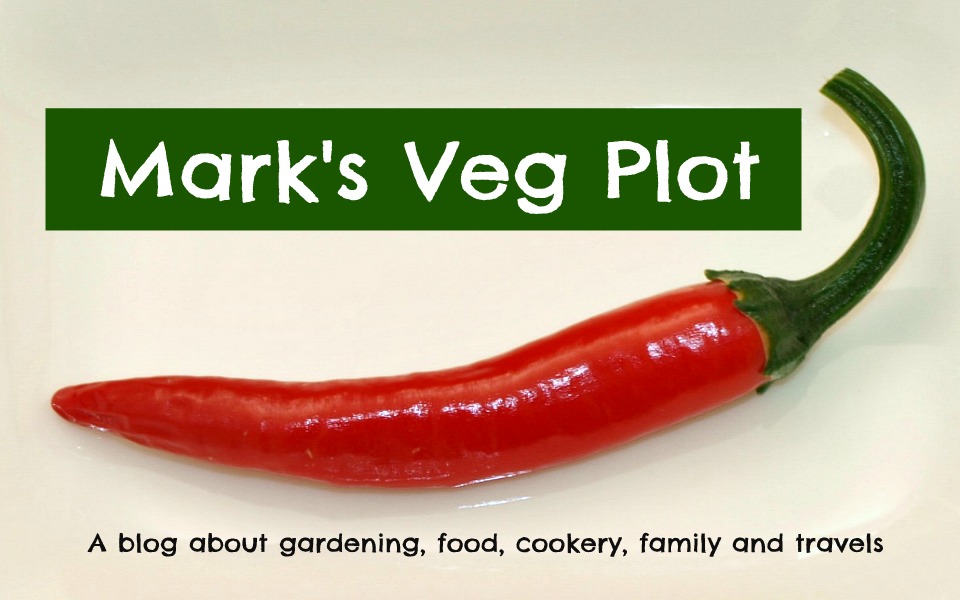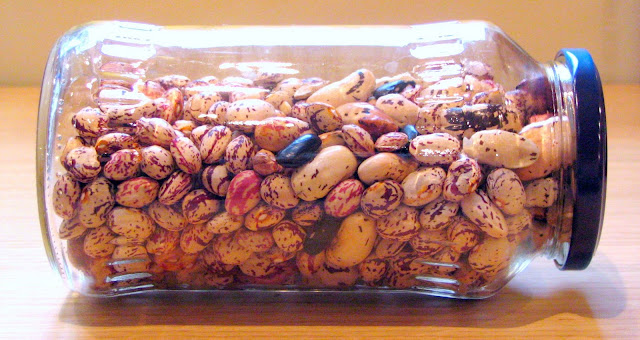Last Summer I grew some of the extravagantly picturesque "Lingua di Fuoco" Borlotti beans
My modest late Summer harvest included a variety of beans - mostly Borlotti, but also a few others like runners and climbing French beans (from the odd few pods that I had missed during earlier pickings). After drying they were stored away in this jar...
The jar has remained in a dark cupboard for a few months, but this week I decided to cook some of the beans. Somehow eating in February something you grew the previous Summer is intensely satisfying! There is not much harvestable in the garden at present (we're into the Hungry Gap), which just makes you think how welcome some dried beans must have been in the days before freezing and canning food was possible.
The first step was to soak the beans for a few hours in plenty of water. Boiling water from the kettle gets them started quickly. After a while they swell up and the skins go a bit wrinkly...
I cooked the beans in advance of the rest of my dish. Ten minutes at a fast boil, followed by about 30 minutes at a simmer, after which they were tender and creamy.
The dish I decided to cook was one that involved Italian-style sausages (I actually used Catalan ones, with lots of fennel seed in them), cherry tomatoes, and fresh green beans as well. I removed the skins from the sausages and cut them into small pieces so that they were like meatballs.
Jane baked some bread to go with the meal - it was a sort of Foccacia-style loaf with crushed juniper berries and fresh thyme (from the garden) in it. After baking, the loaf is brushed with olive oil and sprinkled with coarse salt crystals.
I served my dish with some tagliatelli and a bottle of Italian red wine (it was a 2007 Squinzano from Monte Nobile in the Puglia region of southern Italy). Unfortunately, in my haste to get on and eat the meal, the pictures I took were rather rushed and therefore not of good quality. This it the best of the bunch:
Of course it was accompanied by that lovely bread...
Jane says this is a "left-handed" picture. You can see that the handle of the knife is to the left, and I have cut the loaf from the left side. Yes, I'm left-handed!
In retrospect, I think maybe the tagliatelli were superfluous. The beans were beautiful - plump and soft, almost creamy in texture. The sausage was firm and meaty and subtly spiced with the fennel seed. The bread was delicious too - redolent, with the herbs, of some sun-drenched Mediterranean hillside - so the pasta was definitely overshadowed!
The best bit of all this is the fact that I only used about a third of my dried beans (approx 200g, that is), so I will be able to make a couple more dishes too. Watch this space...



What a great idea to store your extra beans, for some reason Mark this never actually occurred to me. And last year beans were by far my best performers.
ReplyDeleteI like a good left hander Mark, my eldest son is left handed and I am encountering difficulties in trying to help him write, hopefully it will all work out in the end though. Tell me, do you know if you knit any differently? I knit and my son wants to learn, but I am not sure if I should show him how I do it, or try to do it left handed.
Now as delicious as your dish looks, and it certainly does look delicious, I would absolutely love the recipe for that bread. Thyme and juniper berries, my goodness... that's some fancy eating :)
Ali, I have no experience with knitting, but I'm reliably informed that while it is possible to knit left-handed, it is more normal to do it right-handedly even if you are left-handed! Jane has a recipe for the juniper bread, which she will dig out soon (she normally makes it instinctively).
ReplyDeleteMmmm, my sort of meal. I thought you had a Valentine's Day post, given the beautiful pink colour.
ReplyDeleteMark, I love the photo of the beans at top of your blog almost as much as photo of your peppers!!The meal looks delicious, altogether. The addition of Jane's tasty bread made the whole thing a feast.
ReplyDeleteAs you know I tried growing a 'cooks mix' of beans...but the snails got them. Now I have seen your success with drying and storing, I will make an all out effort next year to do a better job. I have some late planted borlotti in the garden. I hope they have time to set beans before the weather changes. Bread recipe?
ReplyDeleteAh thank you Mark, another friend said that to me too, but coming from a bunch of right handers it just didn't seem right. Ha.
ReplyDeleteYou should have seen my trying to knit leading with my left hand. I felt like I had the fine motor skills of a baby.
Ooo and yes, the recipe. Thank you Jane!
I am with Ali, bread recipe... please. Thanks Jane!
ReplyDeleteThe beans look great too! I keep mine in freezer. If different pests have laid eggs inside the beans, freezing will kill them. Otherwise, i might end up eating beans with bugs. :(
Beautiful looking meal. The bread looks fantastic!
ReplyDeleteOK, OK you all want the bread recipe so here it is! I make my dough in a bread machine so if you don't use one you will need to adjust the order you add the ingredients.
ReplyDeleteThe recipe is on a piece of paper I tore out of a magazine about 15 years ago - I can't remember which magazine it was so I am afraid I can't credit the original writer.
450 g strong white flour
1 level teaspoon salt
1 heaped teaspoon easy-blend dried yeast
30 juniper berries, crushed in a pestle and mortar
1 tablespoon fresh thyme leaves
2 tablespoons olive oil
250 ml water
coarse crystal salt and olive oil for topping
Put the ingredients in your bread machine in the order recommended by the maker, set to "dough" setting and switch on. Grease a baking tin about 23 cm by 33 cm (and line it with non stick paper if it doesn't have a good non-stick surface). When the dough is ready, punch it down then press it roughly into the tin, pressing down hard with your knuckles in a few places to make dimples. Brush all over with about a teaspoonful of olive oil and sprinkle with the salt cystals then leave to rise for about half an hour.
Heat the oven to gas mark 8, 450 F, 230 C and bake the bread for 15 -20 minutes until it sounds hollow when tapped onthe bottom. Stand the cooked loaf on a rack and brush all over with another teaspoon of olive oil then leave to cool.